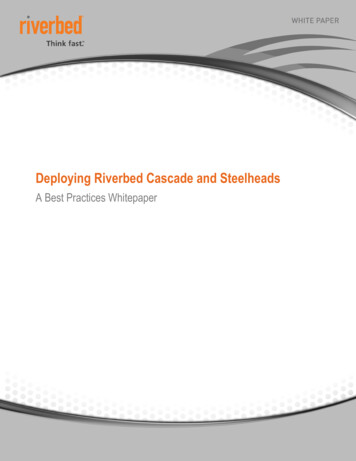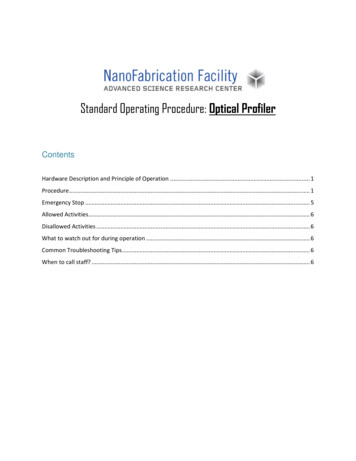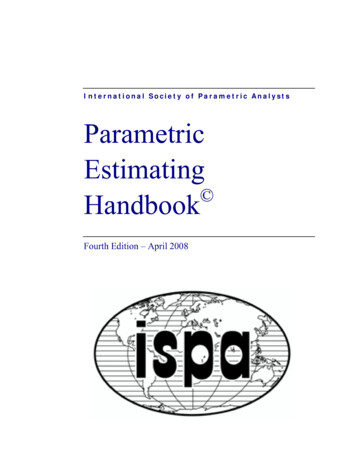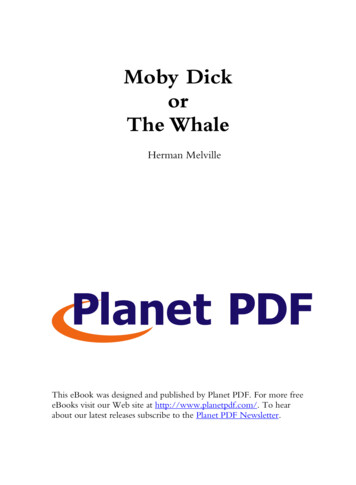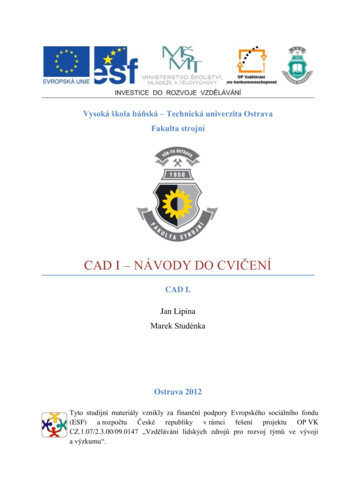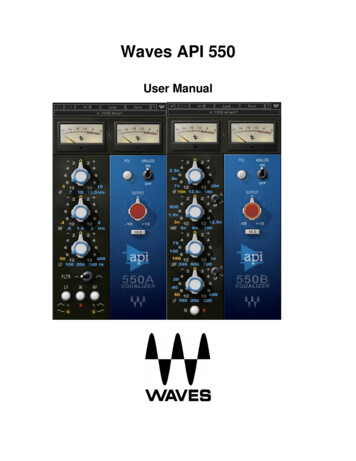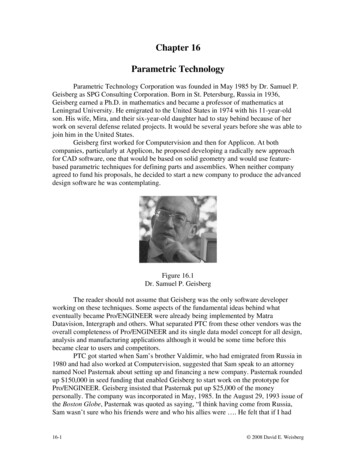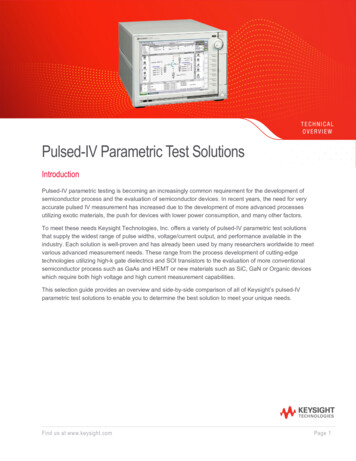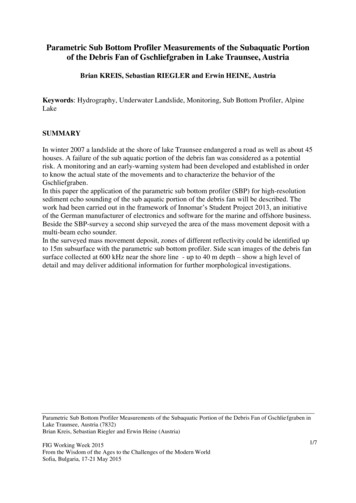
Transcription
Parametric Sub Bottom Profiler Measurements of the Subaquatic Portionof the Debris Fan of Gschliefgraben in Lake Traunsee, AustriaBrian KREIS, Sebastian RIEGLER and Erwin HEINE, AustriaKeywords: Hydrography, Underwater Landslide, Monitoring, Sub Bottom Profiler, AlpineLakeSUMMARYIn winter 2007 a landslide at the shore of lake Traunsee endangered a road as well as about 45houses. A failure of the sub aquatic portion of the debris fan was considered as a potentialrisk. A monitoring and an early-warning system had been developed and established in orderto know the actual state of the movements and to characterize the behavior of theGschliefgraben.In this paper the application of the parametric sub bottom profiler (SBP) for high-resolutionsediment echo sounding of the sub aquatic portion of the debris fan will be described. Thework had been carried out in the framework of Innomar’s Student Project 2013, an initiativeof the German manufacturer of electronics and software for the marine and offshore business.Beside the SBP-survey a second ship surveyed the area of the mass movement deposit with amulti-beam echo sounder.In the surveyed mass movement deposit, zones of different reflectivity could be identified upto 15m subsurface with the parametric sub bottom profiler. Side scan images of the debris fansurface collected at 600 kHz near the shore line - up to 40 m depth – show a high level ofdetail and may deliver additional information for further morphological investigations.Parametric Sub Bottom Profiler Measurements of the Subaquatic Portion of the Debris Fan of Gschliefgraben inLake Traunsee, Austria (7832)Brian Kreis, Sebastian Riegler and Erwin Heine (Austria)FIG Working Week 2015From the Wisdom of the Ages to the Challenges of the Modern WorldSofia, Bulgaria, 17-21 May 20151/7
Parametric Sub Bottom Profiler Measurements of the Subaquatic Portionof the Debris Fan of Gschliefgraben in Lake Traunsee, AustriaBrian KREIS, Sebastian RIEGLER and Erwin HEINE, Austria1. BACKGROUNDThe Gschliefgraben valley is situated on the eastern shore of Lake Traunsee in Upper Austria,at the northern rim of the Eastern Alps (Figure 1). During the last centuries, several landslideswere recorded in the Gschliefgraben resulting in major events, which occur nearlyperiodically every 100 years, the last one in 1910. In the course of these enormous massmovements, even settlements were pushed into Lake Traunsee [2]. Geologists found out thatthe mass movements are caused by less permeable clayey-silty layers, which slide on morepermeable silty-sandy-pebbly ones [1]. Especially after repeatedly wet and rainy periods, ahuge amount of water soaks into the ground and leads to a diminished friction between thelayers.Figure 1: Location of the landslide area of Gschliefgraben at Lake TraunseeThe last major event took place in winter 2007. Due to humid weather, a mudslide of 22 ha inarea and of 4 million m³ in volume was reactivated. As the mudslide moved with a maximumdisplacement velocity of 4.7m/day, it endangered a road as well as about 45 houses whichParametric Sub Bottom Profiler Measurements of the Subaquatic Portion of the Debris Fan of Gschliefgraben inLake Traunsee, Austria (7832)Brian Kreis, Sebastian Riegler and Erwin Heine (Austria)FIG Working Week 2015From the Wisdom of the Ages to the Challenges of the Modern WorldSofia, Bulgaria, 17-21 May 20152/7
were located at the alluvial fan. Thus, the Austrian service for torrent, erosion and avalanchecontrol executed several mitigation measures (e.g. installation of drainages and trenches,removal of material, construction of wells), which led to a deceleration of the process, thusthe mudslide is in a stable condition [1]. A failure of the sub aquatic portion of the debris fanwas considered a potential risk, but the results of echo sounding measurements in January,February, May and December 2008 showed only local erosion and a general, minoraccumulation at the flanks of the fan, no signs of a large-scale failure could be detected [2]. Amonitoring and an early-warning system had been developed and established in order to knowthe actual state of the movements and to characterize the behavior of the Gschliefgraben in thenear future.2. MOTIVATIONIn 2013 a bathymetry case study at Lake Traunsee had been initiated due to new kinds ofhydrographic survey equipment capable of providing substantially higher data density,resolution and accuracy than the traditional sounding methods.The aim of this ongoing project is to explore the usability of different bathymetric systems formonitoring the subaquatic portion of the debris fan, which includes: Multibeam echo sounding (MBES) for a precise mapping of the topography Side scan sonar imaging (SSS) for high resolution imaging of the lake floor and Parametric sub bottom Profiler (SBP) for surveying the sediment structure.In this paper the application of the parametric sub bottom profiler (SBP) for high-resolutionsediment echo sounding of the Gschliefgraben will be described. The work had been carriedout in the framework of Innomar’s Student Project 2013, an initiative of the Germanmanufacturer of electronics and software for the marine and offshore business. The first andthe second author of this paper had been selected out of 20 participants to be supported by thecompany with a SES-2000 parametric sub-bottom profiler and side scan sonar system toperform the scientific survey.The main objectives of the SBP survey were to determine: if it is possible to acquire highly accurate bathymetry and sediment data with thisparametric sub-bottom profiler, in particular as the slope is fairly steep if critical zones, which might reactivate the mass movement, can be discovered if the data can be used for monitoring purposes.Beside the SBP-survey a second ship surveyed the area of the mass movement deposit with amulti-beam echo sounder (Fig.2). This survey had been realized in cooperation of ourdepartment and VERBUND Austrian Hydro Power AG (VHP), the owner of the MBESsurvey vessel.Parametric Sub Bottom Profiler Measurements of the Subaquatic Portion of the Debris Fan of Gschliefgraben inLake Traunsee, Austria (7832)Brian Kreis, Sebastian Riegler and Erwin Heine (Austria)FIG Working Week 2015From the Wisdom of the Ages to the Challenges of the Modern WorldSofia, Bulgaria, 17-21 May 20153/7
Figure 2:Visualization of the debris fan of Gschliefgraben based on multi-beam echosounder and airborne laser scan data3. DATA ACQUISITION AND DATA PROCESSINGThe field work of the survey of the debris fan was carried out in April 2013. The surveyvessel had been equipped with the following measuring instruments (Fig.3): Innomar’s SES-2000 light plus combined sub-bottom profiler and side scan sonarsystem Innomar’s inertial measurement unit MRU-Z One GPS rover, which worked with virtual reference stations, provided by BOKU Two additional GPS antennas to determine the ship’s heading Valeport’s sound velocity profiler owned by BOKU Additionally a narrow beam 200kHz single beam echo sounder (Kongsberg EA400)After installing the system components at the survey vessel, the calibration process of thehydrographic surveying unit had to be undertaken. For this purpose profiles at areas withdiffering depth were surveyed, due to the fact, that the height of subaquatic portion of thedebris fan is about 140m. This procedure was supervised by Mr. Jens Lowag from Innomarbecause of its complexity (for unexperienced users) and the risk of producing wrong results.Parametric Sub Bottom Profiler Measurements of the Subaquatic Portion of the Debris Fan of Gschliefgraben inLake Traunsee, Austria (7832)Brian Kreis, Sebastian Riegler and Erwin Heine (Austria)FIG Working Week 2015From the Wisdom of the Ages to the Challenges of the Modern WorldSofia, Bulgaria, 17-21 May 20154/7
Figure 3: Arrangement of the instruments at the survey vesselFor navigation purposes, a grid consisting of perpendicular and parallel lines to the coast line,was created and imported into the hydrographic data acquisition, navigation and processingsoftware package QINSy. All in all, 60 lines perpendicular and five lines parallel to the coastas well as three side scan lines along the coast were surveyed, covering in total an area ofapproximately 800 m times 600. Some of the profiles were measured in both directions inorder to discover and eliminate remaining errors of the sensor calibration. Furthermore, soundvelocity profiles were recorded each day of the survey.The frequencies used for sub-bottom profiling were 10 kHz for penetrating the lake bed and100 kHz for water depth calculations. In contrast to the side scan line farther away from thecoast, which was recorded with 400 kHz, the signals for the side scan images closer to thecoast were emitted at two frequencies of 400 kHz and 600 kHz with the aim of benefitingfrom different side scan resolutions.The post-processing of Innomar’s data was carried out with the computer programs ISE andSimple Side Scan Processor, respectively. With regards to the measurements of the parametricSBP system, the following procedure was performed for each file:1) The water depth was calculated based on the high frequency (100 kHz) data. Eachprofile was corrected according to the corresponding sound velocity profile andoutliers (spikes) were manually edited.2) The echograms of the processed low frequency data (10 kHz) were geo-referenced andstored as vertical image (curtain), where the image is not flat but follows the track ofthe ship that collected the imagery. This type of visualization class is very useful forimaging the vertical cross-section of the sediment subsurface.3) To be able to compare the results of the bathymetry of 2013 with those from previousmeasurements, the height provided by GNSS system (ETRS89) had to be translated tothe national reference sea level given by the water level of Lake Traunsee was usedParametric Sub Bottom Profiler Measurements of the Subaquatic Portion of the Debris Fan of Gschliefgraben inLake Traunsee, Austria (7832)Brian Kreis, Sebastian Riegler and Erwin Heine (Austria)FIG Working Week 2015From the Wisdom of the Ages to the Challenges of the Modern WorldSofia, Bulgaria, 17-21 May 20155/7
instead of the. Also the horizontal coordinate system was converted from UTM 33N tothe Austrian coordinate system GK M31.4) In a final step, data from three different sources (sub-bottom profiler, single beamecho sounder and multi-beam echo sounder) were merged and displayed with the helpof the 3D Visualization and Analysis Software Fledermaus (Fig.4).4. RESULTSRegarding the water depth calculation, there is just a marginal difference between the depthcalculated with Innomar’s SES-2000 light plus system and the one based on Kongsberg’s EA400. Also the data fits perfectly in the bathymetry layer, which was created with the help ofthe multi-beam echo sounder’s information. Thus, it can be assumed that all three measuringsystems provide highly accurate bathymetry data, although the survey region’s gradient wasrather steep (within approximately 500 m from the coast line, the water depth increased fromcirca 2 m up to nearly 140 m).Innomar’s SES-2000 light plus also provides detailed sub-bottom profiles from the debris fan.In general it was possible to identify three zones in the mass movement deposit (Figure 4): The upper part (from water level to ca. 60 m) consisting of highly reflective material(red colour in echogram) with a layer thickness of up to 5 m. The middle part (from ca. 60 m to ca. 130 m), which is made up of less reflectivematerial (solid rock, blue colour in echogram) characterized by morphologicaldistortions in which layers of sediments could be found in basins. The lower part (below ca. 130 m) with stratified sediment layers in which the signalcould penetrate the bottom up to 15 m. Figure 4:Sub-bottom profiler echogram of Profile 1 embedded in the multi-beam echosounder image (vertical exaggeration factor 2)Parametric Sub Bottom Profiler Measurements of the Subaquatic Portion of the Debris Fan of Gschliefgraben inLake Traunsee, Austria (7832)Brian Kreis, Sebastian Riegler and Erwin Heine (Austria)FIG Working Week 2015From the Wisdom of the Ages to the Challenges of the Modern WorldSofia, Bulgaria, 17-21 May 20156/7
CONCLUSIONAt the subaquatic portion of the debris fan it was possible to acquire highly accuratebathymetry and sediment layer information with Innomar’s SES-2000 light plus measuringsystem. In the surveyed mass movement deposit, zones of different reflectivity could beidentified up to 15m subsurface. Side scan images of the debris fan surface collected at 600kHz near the shore line - up to 40 m depth – show a high level of detail and may deliveradditional information for further morphological investigations.REFERENCES[1] POISEL R., HOFMANN R., PREH A., SAUSGRUBER T., SCHIFFER M. (2011):Lessons learned from Gschliefgraben mudslide (Austria). Geomechanics and Tunneling,Volume 4 Issue 5, p. 445 – 453.[2] MARSCHALLINGER R., EICHKITZ C., GRUBER H., HEIBL K., HOFMANN R.,SCHMID K. (2009): The Gschliefgraben Landslide (Austria): A Remediation Approachinvolving Torrent and Avalanche Control, Geology, Geophysics, Geotechnics andGeoinformatics. Austrian Journal of Earth Sciences, Volume 102/2, p. 36 - 51.CONTACTSDr. Erwin HEINEInstitute of Surveying, Remote Sensing and Land InformationBOKU University of Natural Resources and Life Sciences, ViennaPeter-Jordan-Str. 82ViennaAUSTRIATel. 43 1 47654 5104Fax 43 1 47654 5142Email: erwin.heine@boku.ac.atWeb site: http://geo.boku.ac.at/hydrography/Parametric Sub Bottom Profiler Measurements of the Subaquatic Portion of the Debris Fan of Gschliefgraben inLake Traunsee, Austria (7832)Brian Kreis, Sebastian Riegler and Erwin Heine (Austria)FIG Working Week 2015From the Wisdom of the Ages to the Challenges of the Modern WorldSofia, Bulgaria, 17-21 May 20157/7
Sofia, Bulgaria, 17-21 May 2015 6/7 instead of the. Also the horizontal coordinate system was converted from UTM 33N to the Austrian coordinate system GK M31. 4) In a final step, data from three different sources (sub-bottom profiler, single beam echo sounder and multi-beam
